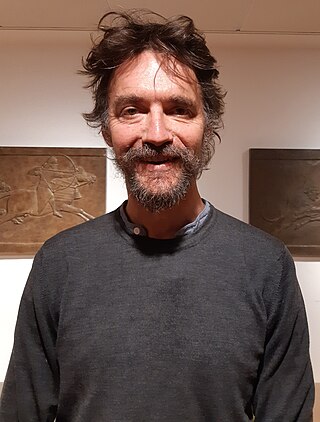Related Research Articles

The Smithsonian Institution, or simply the Smithsonian, is a group of museums, education and research centers, the largest such complex in the world, created by the U.S. government "for the increase and diffusion of knowledge". Founded on August 10, 1846, it operates as a trust instrumentality and is not formally a part of any of the three branches of the federal government. The institution is named after its founding donor, British scientist James Smithson. It was originally organized as the United States National Museum, but that name ceased to exist administratively in 1967.

The Arthur M. Sackler Gallery is an art museum of the Smithsonian Institution in Washington, D.C., focusing on Asian art. The Sackler Gallery and the Freer Gallery of Art together form the National Museum of Asian Art in the United States. The Freer and Sackler galleries house the largest Asian art research library in the country.
The Bene EphraimBnei Ephraim, also called Telugu Jews because they speak Telugu, are a small community living primarily in Kotha Reddy Palem, a village outside Chebrolu, Guntur District, and in Machilipatnam, Krishna District, Andhra Pradesh, India, near the delta of the River Krishna. They claim to be descendants of the Tribe of Ephraim, of the Ten Lost Tribes, and since the 1980s have learned to practice modern Judaism.

The National Museum of African Art is the Smithsonian Institution's African art museum, located on the National Mall of the United States capital. Its collections include 9,000 works of traditional and contemporary African art from both Sub-Saharan and North Africa, 300,000 photographs, and 50,000 library volumes. It was the first institution dedicated to African art in the United States and remains the largest collection. The Washington Post called the museum a mainstay in the international art world and the main venue for contemporary African art in the United States.

Anthony Brown is an American jazz percussionist, composer, bandleader, ethnomusicologist, and educator. He is known for leading, performing, and recording with the Grammy-nominated Asian American Orchestra since its founding in 1998. His compositions blend jazz instruments and improvisation with traditional Asian instruments and sensibilities, and include musical scores for documentary films, for theatrical and dance premieres, and for spoken word and poetry presentations.
Bruce Elliot Tapper is a social anthropologist, journalist, writer, and editor. He has published numerous articles on Telugu society and culture in Andhra Pradesh, and shadow puppets as a form of entertainment. He lived in a small village called Aripaka, close to Visakhapatnam, from 1970-72 to research the social structure and religious customs of the farmers and various other occupational communities in the village.

Richard Kurin, an American cultural anthropologist, museum official and author, is the Acting Provost and Under Secretary for Museums and Research at the Smithsonian Institution. He is a key member of the senior team managing the world's largest museum and research complex with 6,500 employees and a $1.4 billion annual budget, caring for more than 139 million specimens, artifacts and artworks, working in 145 countries around the globe, hosting some 30 million visitors a year, and reaching hundreds of millions online and through the Smithsonian's educational programs and media outreach. Kurin is particularly responsible for all of the national museums, scholarly and scientific research centers, and programs spanning science, history, art and culture.
Jyotindra Manshankar Bhatt, better known as Jyoti Bhatt, is an Indian artist best known for his modernist work in painting and printmaking and also his photographic documentation of rural Indian culture. He studied painting under N. S. Bendre and K.G. Subramanyan at the Faculty of Fine Arts, Maharaja Sayajirao University (M.S.U.), Baroda. Later he studied fresco and mural painting at Banasthali Vidyapith in Rajasthan, and in the early 1960s went on to study at the Academia di Belle Arti in Naples, Italy, as well the Pratt Institute in New York. He was awarded the Padma Shri in 2019 and elected as a Fellow of the Lalit Kala Akademi in 2022.
Dr. Abraham Josevich Kaufman was a Russian-born medical doctor, community organizer and Zionist who helped protect some tens of thousands of Jews seeking safe-haven in East Asia from Nazi atrocities during World War II.

Kenneth Hayes Miller was an American painter, printmaker, and teacher.

Vidya Dehejia is a retired academic and the Barbara Stoler Miller Professor Emerita of Indian and South Asian Art at Columbia University. She has published 24 books and numerous academic papers on the art of South Asia, and has curated many exhibitions on the same theme.

Christopher Pinney is an anthropologist and art historian, and Professor of Anthropology and Visual Culture at University College London in the department of anthropology. He is known for his studies on the visual culture of South Asia, specifically India. He was honoured by the Government of India, in 2013, by bestowing on him the Padma Shri, the fourth highest civilian award, for his contributions to the field of literature.
Pratapaditya Pal is an Indian scholar of Southeast Asian and Himalayan art and culture, specializing particularly in the history of art of India, Nepal and Tibet. He has served as a curator of South Asian art at several prominent US museums including Boston's Museum of Fine Arts, the Los Angeles County Museum of Art, and the Art Institute of Chicago, where he has organized more than 22 major exhibitions and helped build the museums' collection. He has also written over 60 books and catalogs, and over 250 articles on the subject, taught at several universities, and served as the editor of the Indian art magazine, Marg. In 2009 he was awarded Padma Shri by the Government of India for his contributions to the study of Indian art.

David Mordecai (1909-1973) was an Indian photographer in Calcutta whose subjects included the Nehrus, Tenzing Norgay, Sir Edmund Hillary, and King Mahendra and Queen Ratna of Nepal.
Marvin Tokayer is an American Rabbi and author who served as a United States Air Force chaplain in Japan. He was later advised by the Lubavitcher Rebbe to return to Japan where he served for eight years as the only rabbi in the country. Tokayer currently serves as a rabbi in Great Neck, New York.
Saryu Vinod Doshi is an Indian art scholar, art historian, academic and curator, known for her erudition in Indian miniature paintings and Jain art. She is the founder director of the National Gallery of Modern Art, Mumbai and a former pro-tem chairman of the Lalit Kala Akademi, New Delhi. She is the author of several books including Masterpieces of Jain Painting, a monograph on selected Jain art pieces. The Government of India awarded her the fourth highest civilian award of the Padma Shri, in 1999.
Conservation and restoration at the Smithsonian Institution deals with the care of the 138 million artifacts located in the collections of Smithsonian Institution. Work is conducted by one research center, the Museum Conservation Institute (MCI), and by conservators at the Smithsonian's museums, galleries, zoo. Smithsonian conservators provide myriad services to their units, including exhibit preparation of the museum collection and loan objects, advising on object care, training for future generations of conservationists, engaging in routine preventive care on a daily basis, conducting research projects related to the collections, and examining objects for evidence of manufacturing techniques and previous restorations All conservation labs collectively further the mission of the Smithsonian Institution, "the increase and diffusion of knowledge." Founded in 1846 the Smithsonian is the world's largest museum and research complex, consisting of 19 museums and galleries, the National Zoological Park, and nine research facilities.

Sir James Mallinson, 5th Baronet, of Walthamstow is a British Indologist, writer and translator. He is recognised as one of the world's leading experts on the history of medieval Hatha yoga.
Pushkar Sohoni is an architect, and an architectural and cultural historian. He is an associate professor and the chair of the department of Humanities and Social Sciences at the Indian Institute of Science Education and Research, Pune.
Kenneth Victor Young (1933–2017), was an American artist, educator, and designer. He is associated with the Washington Color School art movement. He worked at the Smithsonian Institution as an exhibit designer for 35 years.
References
- ↑ Kenneth X. Robbins Collection & Papers, 1927-1947. Smithsonian Institution. Retrieved 7 September 2015.
- ↑ "Bookshelf". Columbia College Today. 2021-09-13. Retrieved 2022-05-30.